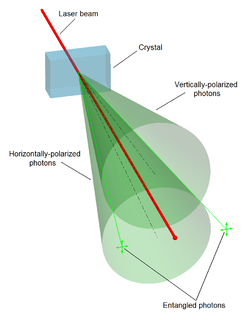In physics, the no-cloning theorem states that it is impossible to create an independent and identical copy of an arbitrary unknown quantum state, a statement which has profound implications in the field of quantum computing among others. The theorem is an evolution of the 1970 no-go theorem authored by James Park, in which he demonstrates that a non-disturbing measurement scheme which is both simple and perfect cannot exist. The aforementioned theorems do not preclude the state of one system becoming entangled with the state of another as cloning specifically refers to the creation of a separable state with identical factors. For example, one might use the controlled NOT gate and the Walsh–Hadamard gate to entangle two qubits without violating the no-cloning theorem as no well-defined state may be defined in terms of a subsystem of an entangled state. The no-cloning theorem concerns only pure states whereas the generalized statement regarding mixed states is known as the no-broadcast theorem.
Quantum teleportation is a technique for transferring quantum information from a sender at one location to a receiver some distance away. While teleportation is commonly portrayed in science fiction as a means to transfer physical objects from one location to the next, quantum teleportation only transfers quantum information. The sender does not have to know the particular quantum state being transferred. Moreover, the location of the recipient can be unknown, but classical information needs to be sent from sender to receiver to complete the teleportation. Because classical information needs to be sent, teleportation can not occur faster than the speed of light.
In quantum computing, a qubit or quantum bit is a basic unit of quantum information—the quantum version of the classic binary bit physically realized with a two-state device. A qubit is a two-state quantum-mechanical system, one of the simplest quantum systems displaying the peculiarity of quantum mechanics. Examples include the spin of the electron in which the two levels can be taken as spin up and spin down; or the polarization of a single photon in which the two states can be taken to be the vertical polarization and the horizontal polarization. In a classical system, a bit would have to be in one state or the other. However, quantum mechanics allows the qubit to be in a coherent superposition of both states simultaneously, a property that is fundamental to quantum mechanics and quantum computing.

Quantum entanglement is the physical phenomenon that occurs when a group of particles are generated, interact, or share spatial proximity in a way such that the quantum state of each particle of the group cannot be described independently of the state of the others, including when the particles are separated by a large distance. The topic of quantum entanglement is at the heart of the disparity between classical and quantum physics: entanglement is a primary feature of quantum mechanics lacking in classical mechanics.
In physics, the CHSH inequality can be used in the proof of Bell's theorem, which states that certain consequences of entanglement in quantum mechanics can not be reproduced by local hidden variable theories. Experimental verification of violation of the inequalities is seen as experimental confirmation that nature cannot be described by local hidden variables theories. CHSH stands for John Clauser, Michael Horne, Abner Shimony, and Richard Holt, who described it in a much-cited paper published in 1969. They derived the CHSH inequality, which, as with John Bell's original inequality, is a constraint on the statistics of "coincidences" in a Bell test which is necessarily true if there exist underlying local hidden variables. This constraint can, on the other hand, be infringed by quantum mechanics.

Quantum decoherence is the loss of quantum coherence. In quantum mechanics, particles such as electrons are described by a wave function, a mathematical representation of the quantum state of a system; a probabilistic interpretation of the wave function is used to explain various quantum effects. As long as there exists a definite phase relation between different states, the system is said to be coherent. A definite phase relationship is necessary to perform quantum computing on quantum information encoded in quantum states. Coherence is preserved under the laws of quantum physics.

Second quantization, also referred to as occupation number representation, is a formalism used to describe and analyze quantum many-body systems. In quantum field theory, it is known as canonical quantization, in which the fields are thought of as field operators, in a manner similar to how the physical quantities are thought of as operators in first quantization. The key ideas of this method were introduced in 1927 by Paul Dirac, and were developed, most notably, by Vladimir Fock and Pascual Jordan later.

In quantum computing and specifically the quantum circuit model of computation, a quantum logic gate is a basic quantum circuit operating on a small number of qubits. They are the building blocks of quantum circuits, like classical logic gates are for conventional digital circuits.
Quantum error correction (QEC) is used in quantum computing to protect quantum information from errors due to decoherence and other quantum noise. Quantum error correction is theorised as essential to achieve fault-tolerant quantum computation that can reduce the effects of noise on stored quantum information, faulty quantum gates, faulty quantum preparation, and faulty measurements.
The Bell states or EPR pairs are specific quantum states of two qubits that represent the simplest examples of quantum entanglement; conceptually, they fall under the study of quantum information science. The Bell states are a form of entangled and normalized basis vectors. This normalization implies that the overall probability of the particle being in one of the mentioned states is 1: . Entanglement is a basis-independent result of superposition. Due to this superposition, measurement of the qubit will "collapse" it into one of its basis states with a given probability. Because of the entanglement, measurement of one qubit will "collapse" the other qubit to a state whose measurement will yield one of two possible values, where the value depends on which Bell state the two qubits are in initially. Bell states can be generalized to certain quantum states of multi-qubit systems, such as the GHZ state for 3 or more subsystems.

LOCC, or local operations and classical communication, is a method in quantum information theory where a local (product) operation is performed on part of the system, and where the result of that operation is "communicated" classically to another part where usually another local operation is performed conditioned on the information received.

In physics, in the area of quantum information theory, a Greenberger–Horne–Zeilinger state is a certain type of entangled quantum state that involves at least three subsystems. It was first studied by Daniel Greenberger, Michael Horne and Anton Zeilinger in 1989. Extremely non-classical properties of the state have been observed.
The W state is an entangled quantum state of three qubits which in the bra-ket notation has the following shape
In linear algebra, the Schmidt decomposition refers to a particular way of expressing a vector in the tensor product of two inner product spaces. It has numerous applications in quantum information theory, for example in entanglement characterization and in state purification, and plasticity.
The time-evolving block decimation (TEBD) algorithm is a numerical scheme used to simulate one-dimensional quantum many-body systems, characterized by at most nearest-neighbour interactions. It is dubbed Time-evolving Block Decimation because it dynamically identifies the relevant low-dimensional Hilbert subspaces of an exponentially larger original Hilbert space. The algorithm, based on the Matrix Product States formalism, is highly efficient when the amount of entanglement in the system is limited, a requirement fulfilled by a large class of quantum many-body systems in one dimension.
In the case of systems composed of subsystems, the classification of quantum-entangledstates is richer than in the bipartite case. Indeed, in multipartite entanglement apart from fully separable states and fully entangled states, there also exists the notion of partially separable states.
In physics, the no-deleting theorem of quantum information theory is a no-go theorem which states that, in general, given two copies of some arbitrary quantum state, it is impossible to delete one of the copies. It is a time-reversed dual to the no-cloning theorem, which states that arbitrary states cannot be copied. This theorem seems remarkable, because, in many senses, quantum states are fragile; the theorem asserts that, in a particular case, they are also robust. Physicist Arun K. Pati along with Samuel L. Braunstein proved this theorem.
Entanglement distillation is the transformation of N copies of an arbitrary entangled state into some number of approximately pure Bell pairs, using only local operations and classical communication.

As part of network science, the study of quantum complex networks aims to explore the impact of complexity science and network architectures in quantum systems. According to quantum information theory, it is possible to improve communication security and data transfer rates by taking advantage of quantum mechanics. In this context, the study of quantum complex networks is motivated by the possibility of quantum communications being used on an enterprise scale in the future. In this case, it is likely that quantum communication networks will acquire nontrivial features, as is common in existing communication networks today.
Optical cluster states are a proposed tool to achieve quantum computational universality in linear optical quantum computing (LOQC). As direct entangling operations with photons often require nonlinear effects, probabilistic generation of entangled resource states has been proposed as an alternative path to the direct approach.









































